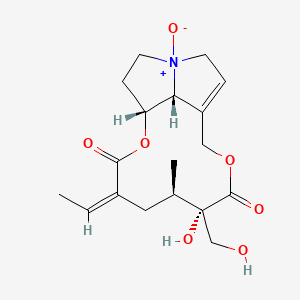
Synopsis
Synopsis
0
API Suppliers
0
USDMF
0
CEP/COS
0
JDMF
0
EU WC
0
KDMF
0
NDC API
0
VMF
0
Listed Suppliers
0
FDF Dossiers
0
FDA Orange Book

0
Europe

0
Canada

0
Australia

0
South Africa

0
Listed Dossiers
DRUG PRODUCT COMPOSITIONS
0
US Patents
0
US Exclusivities
0
Health Canada Patents
US Medicaid
NA
Annual Reports
NA
Regulatory FDF Prices
NA
0
API
0
FDF
0
Data Compilation #PharmaFlow
0
Stock Recap #PipelineProspector
0
Weekly News Recap #Phispers
0
News #PharmaBuzz


1. Ret-no
2. Retrorsine N-oxide
1. Retrorsine N-oxide
2. 15503-86-3
3. (5r,6s,9a1r,14ar,z)-3-ethylidene-6-hydroxy-6-(hydroxymethyl)-5-methyl-2,7-dioxo-3,4,5,6,7,9,9a1,11,12,13,14,14a-dodecahydro-2h-[1,6]dioxacyclododecino[2,3,4-gh]pyrrolizine 12-oxide
4. [1,6]dioxacyclododecino[2,3,4-gh]pyrrolizine-2,7-dione, 3-ethylidene-3,4,5,6,9,11,13,14,14a,14b-decahydro-6-hydroxy-6-(hydroxymethyl)-5-methyl-, 12-oxide, (3z,5r,6s,14ar,14br)-
5. Chebi:5977
6. Dtxsid4020747
7. Retrorsine-n-oxide , Hplc Grade
8. Zinc4098666
9. Mfcd00074872
10. Hy-116832
11. Cs-0066628
12. Q27106956
13. (3z,5r,6s,14ar,14br)-3-ethylidene-6-hydroxy-6-(hydroxymethyl)-5-methyl-3,4,5,6,9,11,13,14,14a,14b-decahydro[1,6]dioxacyclododecino[2,3,4-gh]pyrrolizine-2,7-dione 12-oxide
| Molecular Weight | 367.4 g/mol |
|---|---|
| Molecular Formula | C18H25NO7 |
| XLogP3 | 0 |
| Hydrogen Bond Donor Count | 2 |
| Hydrogen Bond Acceptor Count | 7 |
| Rotatable Bond Count | 1 |
| Exact Mass | 367.16310214 g/mol |
| Monoisotopic Mass | 367.16310214 g/mol |
| Topological Polar Surface Area | 111 Ų |
| Heavy Atom Count | 26 |
| Formal Charge | 0 |
| Complexity | 673 |
| Isotope Atom Count | 0 |
| Defined Atom Stereocenter Count | 4 |
| Undefined Atom Stereocenter Count | 1 |
| Defined Bond Stereocenter Count | 1 |
| Undefined Bond Stereocenter Count | 0 |
| Covalently Bonded Unit Count | 1 |
Isatidine is not converted into pyrrolic metabolites by isolated rat liver microsomes. It is, However, reduced to retrorsine in the intestinal tract of rats, possibly by the gut flora, thus accounting for the large increase in toxicity when isatidine is administered by mouth rather than parenterally.
IARC. Monographs on the Evaluation of the Carcinogenic Risk of Chemicals to Humans. Geneva: World Health Organization, International Agency for Research on Cancer, 1972-PRESENT. (Multivolume work). Available at: https://monographs.iarc.fr/ENG/Classification/index.php, p. V10 272 (1976)
Levels of pyrrolic metabolites bound to liver tissues and responsible for hepatotoxicity in rats given pyrrolizidine alkaloids did not reflect rates of formation of such metabolites measured in vitro. In animals, additional factors could influence formation and tissue binding of pyrrolic metabolites, including detoxication of alkaloids by hydrolysis and chemical reactivity and stability of toxic metabolites.
PMID:6825198 Mattocks A et al;Chem-Biol Interact 43(2): 209 (1983)
REF. STANDARDS & IMPURITIES

ABOUT THIS PAGE
29
PharmaCompass offers a list of Isatidine API manufacturers, exporters & distributors, which can be sorted by GMP, USDMF, JDMF, KDMF, CEP (COS), WC, Price,and more, enabling you to easily find the right Isatidine manufacturer or Isatidine supplier for your needs.
Send us enquiries for free, and we will assist you in establishing a direct connection with your preferred Isatidine manufacturer or Isatidine supplier.
PharmaCompass also assists you with knowing the Isatidine API Price utilized in the formulation of products. Isatidine API Price is not always fixed or binding as the Isatidine Price is obtained through a variety of data sources. The Isatidine Price can also vary due to multiple factors, including market conditions, regulatory modifications, or negotiated pricing deals.
A Isatidine manufacturer is defined as any person or entity involved in the manufacture, preparation, processing, compounding or propagation of Isatidine, including repackagers and relabelers. The FDA regulates Isatidine manufacturers to ensure that their products comply with relevant laws and regulations and are safe and effective to use. Isatidine API Manufacturers are required to adhere to Good Manufacturing Practices (GMP) to ensure that their products are consistently manufactured to meet established quality criteria.
A Isatidine supplier is an individual or a company that provides Isatidine active pharmaceutical ingredient (API) or Isatidine finished formulations upon request. The Isatidine suppliers may include Isatidine API manufacturers, exporters, distributors and traders.
Isatidine Active pharmaceutical ingredient (API) is produced in GMP-certified manufacturing facility.
GMP stands for Good Manufacturing Practices, which is a system used in the pharmaceutical industry to make sure that goods are regularly produced and monitored in accordance with quality standards. The FDA’s current Good Manufacturing Practices requirements are referred to as cGMP or current GMP which indicates that the company follows the most recent GMP specifications. The World Health Organization (WHO) has its own set of GMP guidelines, called the WHO GMP. Different countries can also set their own guidelines for GMP like China (Chinese GMP) or the EU (EU GMP).
PharmaCompass offers a list of Isatidine GMP manufacturers, exporters & distributors, which can be sorted by USDMF, JDMF, KDMF, CEP (COS), WC, API price, and more, enabling you to easily find the right Isatidine GMP manufacturer or Isatidine GMP API supplier for your needs.
A Isatidine CoA (Certificate of Analysis) is a formal document that attests to Isatidine's compliance with Isatidine specifications and serves as a tool for batch-level quality control.
Isatidine CoA mostly includes findings from lab analyses of a specific batch. For each Isatidine CoA document that a company creates, the USFDA specifies specific requirements, such as supplier information, material identification, transportation data, evidence of conformity and signature data.
Isatidine may be tested according to a variety of international standards, such as European Pharmacopoeia (Isatidine EP), Isatidine JP (Japanese Pharmacopeia) and the US Pharmacopoeia (Isatidine USP).
